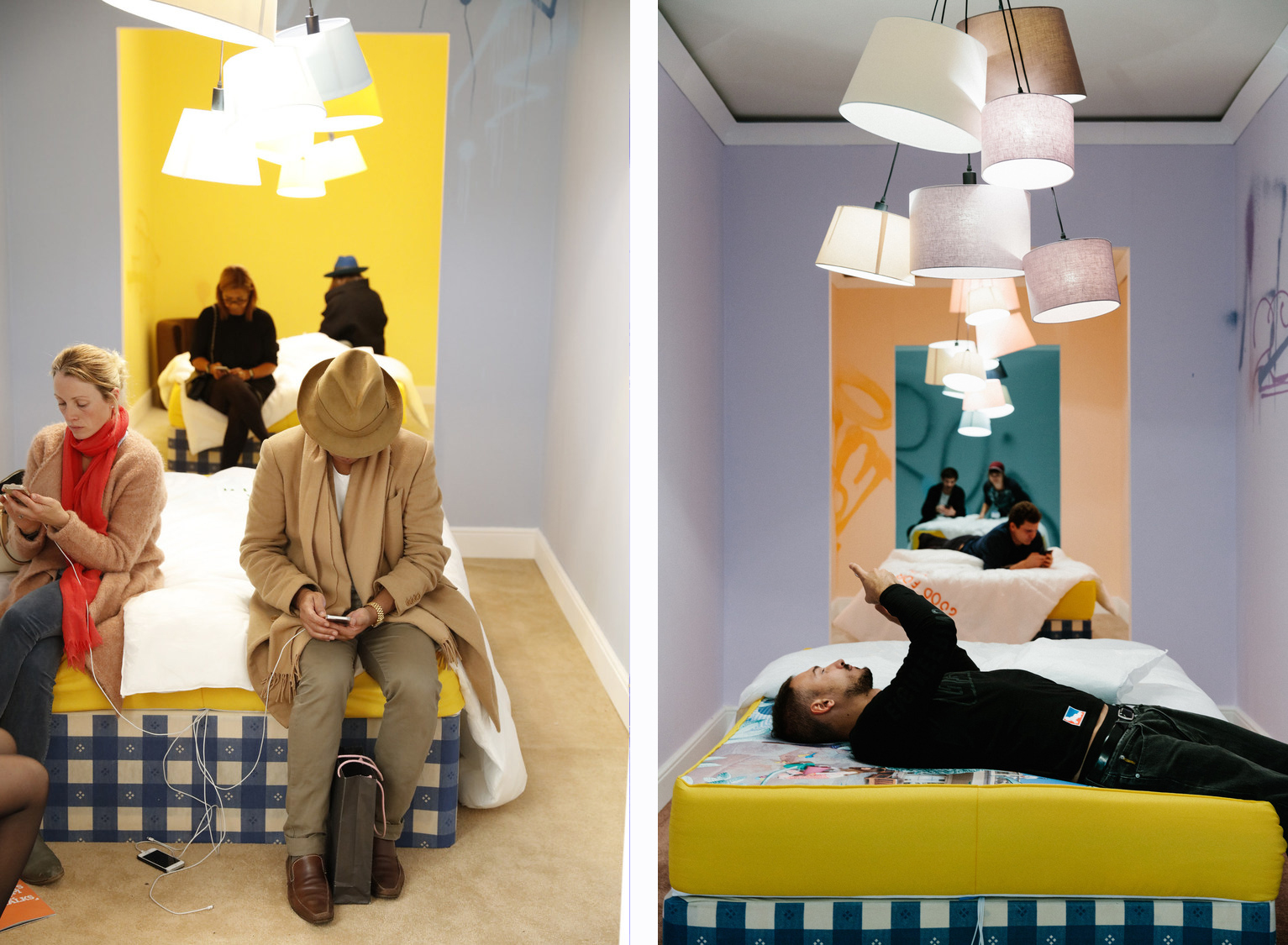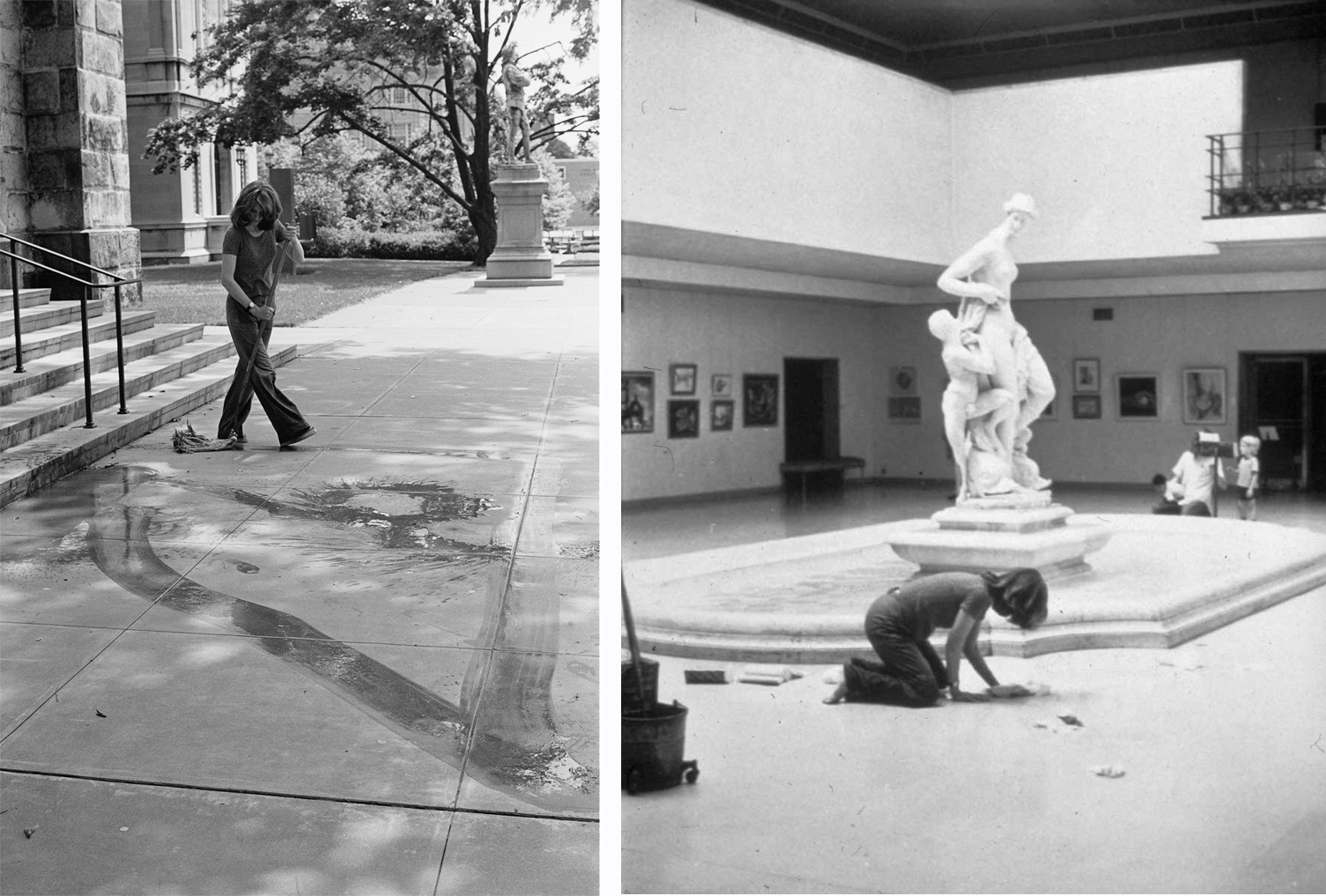House-Work
By Ushma Thakrar Working conditions have changed drastically from those in the factory of the early Industrial Era, when methods of production were both uniform and equalizing. A degree of individualization took place upon the onset of the Information Age, with its quasi-private cubicles and corner offices for white-collar America defining the form of labor in the latter half of the 20th century. Contemporary working conditions are currently reaching a climax in privatization and individualism through a familiar setting: the home. It is not the space of the home office per se, but a much more pervasive condition in which the home is an office: coffee is brewed in a Chemex rather than dispensed from a plastic-pod, a bed adopts the function of a desk, the bedroom that of a private office, roommates replace the physical presence of co-workers and a webcam subsumes the conference room. This relatively new site for economic labour has come to be synonymous with flexibility in work schedules and the complete customization of the workplace − in short, a complete individualization the working experience. It is this individualization that has led to the space of the home becoming the idealized site for work in the contemporary imaginary − both for employees and for an ever-growing number of employers.

Though it is still something of a novelty, working from home has long been facilitated by innovations in telecommunication technologies. Hugh Hefner is photographed in the 1960s seated on his bed-converted-recording-studio. While the bed anchors a domestic space par excellence, its state in this image alludes to work-in-progress: the slew of papers surround the subject, the circle of televisions, projection screens, and multiple telephones enclose him as he is linked out. Hefner's work is indicated by connections to the public realm, even from his presence in an acutely domestic site.

The architect Aristide Antonas frequently works with this imaginary of the domestic space of the bed as a site for work. Antonas' formulation expands from work to all forms of participation in the public sphere as taking place from the bed. His illustrations and installations each depict the bed fitted with devices that provide access to the Internet. The relative ease of access to the Internet and its widespread use in productive and purely social capacities, allow for the complete sublimation of the public sphere with a connected device, without necessarily leaving the private one. Comfort Zone, by the artists’ collective åyr further reduces the technology to a set of outlets, given the recent status of telecommunication technologies as extensions of the human body, rather than fixed in any given space.

While these advancements in telecommunications technologies have certainly facilitated the prospect of working from home, the novelty and current popularity of working from home isn’t reducible to a bedside fax machine. The novelty that has given this form of work its privileged status is in the vector of its displacement: its direction from the office towards the space of the home, the private realm. Hilde Heynen explains how the work space had previously coincided with the domestic space in writing: “Before the nineteenth century, the house was far less part of the private/public dichotomy that we have come to associate with it, nor did it bear the clearly gendered overtones that suggest that the house first belongs to the mother.”(1) Since this initial movement of economic labour out of the house, it has been the occupation of feminist practices to likewise move domestic labour out of the home and into the public realm.

The performance artist Mirele Laderman Ukeles provides an example of domestic work moving into the public sphere with her series Maintenance Art (above, below). While Ukeles' performances were not compensated as a fulfillment of domestic necessities, it can be assumed that the series was evaluated through Ukeles’ position as artist and the work’s status as performance. Even if the performances didn't achieve the status of economic labour in the public sphere, her work did alter the relationship between the public and private spheres, relative to her position as both labourer and critic of that labour. In her book The Human Condition, Hannah Arendt defines the private realm as the site of human necessity and the pre-political behaviours of humans that must take place behind closed doors, while the public realm is the privileged location of the political and of human discourse. (2) Through this dichotomization of space, Ukeles' movement of domestic work into spaces outside of the private, individual dwelling as a pre-political act continues to be defined as individual and extra-economic actions that belong unilaterally to the private realm. The artist's performances purposefully extend the space of the private sphere to extend beyond the site of the house. All that the artist takes into her care through her uncompensated maintenance becomes domesticated by the very act.

Less performative movements of domestic labour out of the home have been implemented through a variety of other mechanisms, as early as the late 19th century, all with the primary goal of compensating this form of work. As socialist and feminist reactions to life amidst industrialized labor, these strategies have been differentiated by the degrees of individualization or standardization assumed by domestic processes and products as they entered the public domain. It was (and remains) a question of what work could be collectivized and hence compensated without entirely destroying the individuality of the bourgeois home, as the very labours that produced, maintained and broadcasted it were actively being displaced from this site. Designs like August Bebel’s Industrial Strategy completely standardized domestic labour, by moving it to the factory space, while a group of material feminists, led by Melusina Fay Peirce, opted for the collectivization of domestic work at the neighbourhood scale − in their aptly named Neighbourhood Strategy − such that it maintained a degree of individual specificity. These arrangements allude to an understanding of domestic labour at the scale of the single household as too specific and individualized to produce concrete economic value. The secondary concern is evident in the continued maintenance of the personal touch as a necessary but uncapitalized individual labour: a fear of degradation of the private realm. As it was assumed that basic human necessities, traditionally provided within the home, were satisfactorily fulfilled from the work done outside of the home, this fear was instead based in a conflation of the private with the individual. These concepts have only become more intertwined since the post-war years, when advertising, largely created for women homemakers, sought to differentiate identical products through branding and value-association. Likewise, conspicuous consumption at home and for the home has grown exponentially in scale and prevalence as the predominant means of individualizing oneself from the mass. The walls of the house were not jeopardized by the standardization of domestic labor in the public realm, nor by these new appearances of homemaking in the mass market. At stake was the degradation of individuality: a burgeoning value in the post-war economy that has today under the Neoliberal condition become the fundamental generator of value in and of itself.
When this idealization of working from home is contextualized through its spatial intersection with domestic labour, rather than simply understood as a byproduct of telecommunications, it engenders a social condition that is symptomatic of the particular value of individualism. In his essay "The Unhomely Bed," Aristide Antonas describes a contemporary tendency of retreat into the private sphere, specifically into the bed: "The tendency to retreat into a private room of one's own could be understood either as a concession toward societal conditions or as a rejection of the public sphere." (3) While Antonas understands the movement of work into the house as a rejection of the public sphere through the over-valuation of individuality in the Neoliberal condition, it could also be understood that this kind homecoming is not for the sake of further individualizing work, but is rather a condition that has been catalyzed by the nature of advanced capitalism.
Hannah Arendt has written, "The activity of labour does not need the presence of others, though a being labouring in complete solitude would not be human but an animal labourans in the word's most literal significance." (4) Thus, even in considering the dissolution of office work into the individual space of the home, the work, as performed by humans, must be understood as a social rather than purely economic retreat. Domestic labour, though relegated to private realm through its being defined as sheer animal necessity by Arendt, is likewise a social work. Dipesh Chakrabarty writes of the role of housework, specifically the act of classifying and removing garbage from the interior, in the delineating between and construction of the public and private spheres in his essay “Of Garbage, Modernity and the Citizen’s Gaze”:
"We must start with the proposition that the problem of dirt poses, in turn, the problem of the outside. For whether we are talking about radioactive waste from the industrialized countries or the waste of a household or of village in India, the dirt can go only to a place that is designated as outside. The fact that the dirt goes out of the house implies a boundary between the inside and the outside. The boundary does not simply delineate a hygienic space where cleanliness is practiced." (5)
If we allow for the extension of Chakrabarty’s argument to include the full spectrum of “pre-political” domestic work that is outside the realm of financial compensation, the private sphere and the human activities assigned to it are the very generators of the public sphere. Whether or not domestic labour is compensated economically, it is the force that creates the condition that makes any other form of work possible: there is no working from home, if there is no housework. The formal exclusion of this work from the public sphere functionally oppresses individuals to maintain the status-quo through both the over-arching political ideology of Neoliberalism and the condition of hyper-capitalism under which this work takes place today. The domestic work that has traditionally been and continues to be excluded from the public sphere is then not pre-political, but biopolitical. Perhaps it is through this lens that we must likewise understand the status of paid work, as it increasingly situated in the physical space of the private realm. The current condition of hyper-capitalism, in which our domestic labours and our professional occupations are highly individuated, is creating what seems to be an inescapable condition. Our autonomy and self-sufficiency seem to have reached a low-point, given the degrees to which we have to individuate ourselves and specialize in increasingly niche fields. Our general skills become limited to more particular applications, resulting in a greater dependence on the skills and knowledge of others. All this is taking place in parallel to a system of Neoliberal governance that privileges the logic of the free-market to the point of completely eliminating social welfare. Under this framework of capitalism, forced dependencies and austerity measures, individual work that was previously performed in the public sphere becomes an individual necessity for survival, though this work continues to fulfill its social utility. In our contemporary condition, both uncompensated housework and financially-compensated work have been consigned to and constrained to the space of the individual dwelling. And though both of these occupations are fundamental to the construction, maintenance and operation of the public realm, they are excluded from it such that homebound labor is not only undervalued, but exploitative of the individual labourer.
(1) Hilde Heynen “Modernity and Domesticity: Tensions and Contradictions” in Negotiating Domesticity: Spatial Productions of Gender in Modern Architecture, eds. Hilde Heynen and Gülsüm Baydar. London: Routledge, 2005. pp.1 - 29: 7
(2) Hannah Arendt, The Human Condition. (Chicago, Il: University of Chicago Press, 1969): 22-49
(3) Aristide Antonas, "The Unhomely Bed" in Jesko Fezer, Martin Hager and Christian Hiller (eds.), Hannes Meyer: Co-op Interieur Wohnungstrage, (Leipzig: Spector Books, 2015): 41
(4) Arendt, 22
(5) Dipesh Chakrabarty. "Of Garbage, Modernity and the Citizen's Gaze" in Dipesh Chakrabarthy, Habitations of Modernity: Essays in the Wake of Subaltern Studies. (Chicago, Il: University of Chicago Press, 2002): 69

f-architecture (alt: feminist architecture collaborative) is a three-woman research enterprise aimed at disentangling the contemporary spatial politics and technological appearances of bodies, intimately and globally. Partners/caryatids/bffs Gabrielle Printz, Virginia Black and Rosana Elkhatib run their practice out of the GSAPP Incubator at NEW INC, an initiative of the New Museum.

